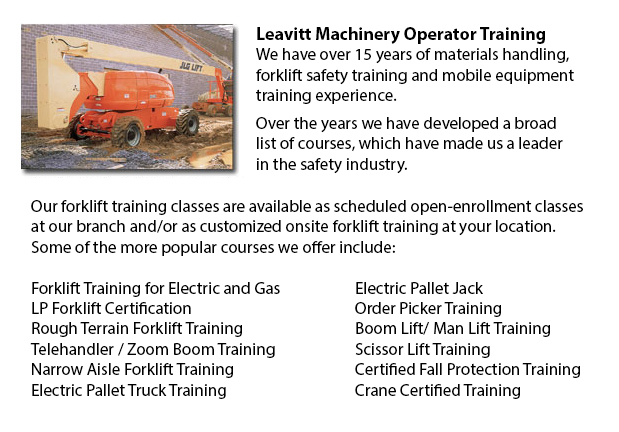
Boom Lift Safey Training Ottawa - Boom lifts fall under the kind of elevated work platform or aerial lifting device. Most usually used in warehousing, construction and industry; the boom lift is so versatile that it could be used in almost any setting.
The elevated work platform is used to be able to allow access to heights which were otherwise not reachable utilizing other methods. There are dangers inherent when utilizing a boom lift device. Employees who operate them have to be trained in the proper operating techniques. Accident avoidance is vital.
The safety factors that are involved in boom lift operation are covered in our Boom Lift Training Programs. The course is suitable for individuals who operate self-propelled boom supported elevated work platforms and self-propelled elevated work platforms. Upon successfully finishing the course, participants would be given a certificate by someone qualified to confirm the completion of a hands-on assessment.
To help train operators in the safe utilization of elevated work platforms, industry agencies, local and federal regulators, and lift manufacturers all play a part in establishing standards and providing the necessary information. The most essential ways to prevent accidents connected to the utilization of elevated work platforms are the following: performing site assessments; inspecting machines; and having on safety gear.
Key safety considerations when operating Boom lifts:
Operators should observe the minimum safe approach distance (or also called MSAD) from power lines. Voltage could arc across the air to be able to find an easy path to ground.
So as to maintain stability as the platform nears the ground, a telescopic boom needs to be retracted prior to lowering a work platform.
People working from the platform of a Boom lift should tie off to be able to ensure their safety. lanyard and safety harness combinations should not be connected to any anchorage other than that provided by the manufacturer, never to other wires or poles. Tying off may or may not be necessary in scissor lifts, depending on specific job risks, local rules, or employer guidelines.
The maximum slope would be specified by the manufacturer. Workers should avoid working on a slope, if possible. When the slope is beyond recommended situation, the lifting device should be transported or winched over the slope. A grade could be measured without problems by laying a straight board or edge of at least 3 feet on the slope. After that a carpenter's level could be laid on the straight edge and raising the end until it is level. The percent slope is attained by measuring the distance to the ground (also called the rise) and dividing the rise by the length of the straight edge. Then multiply by one hundred.
-
Telehandler Ticket Ottawa
Telehandler Ticket Ottawa - The telehandler or telescopic handler is a commonly utilized equipment in industrial and agricultural applications. This machine is the same in look to a forklift and also functions in a similar manner, though telehandlers... More -
Telehandler License Ottawa
Telehandler License Ottawa - The telehandler or telescopic handler is a frequently used machine in industrial and agricultural applications. This particular equipment is the same in appearance to a forklift and even functions in a similar way, althou... More -
Forklift Training Courses Ottawa
Forklift Training Courses Ottawa - Our forklift operator safety training has been tailored for illiteracy, thus cutting the training time in half. We provide forklift training certification, lift-truck operator driver safety training evaluation, and... More -
Boom Lift Certification Ottawa
Boom Lift Certification Ottawa - Making use of elevated work platforms allow for work and maintenance operations to be carried out at elevated work heights which were otherwise unreachable. Workers using scissor lifts and boom lifts can be educated i... More -
Aerial Platform Training Ottawa
Aerial Platform Training Ottawa - Aerial lifts might be used to accomplish certain different duties done in hard to reach aerial spaces. Many of the tasks associated with this style of lift include performing routine upkeep on structures with high ce... More -
Loader Operator Certification Ottawa
Loader Operator Certification Ottawa - Ways To Acquire A Loader Operator Certification - Loader Operator Certification is normally needed for personnel working within construction, warehouse or industrial setting to ensure the safe operation of forkl... More -
Aerial Lift / Boom Lift / Man Lift / Scissor Lift Training in Ottawa
Lift tables or also referred to as scissor hoists can raise both individuals and goods vertically. They are normally utilized in commercial, industrial and construction environments. Commonly, the use of a scissor lift truck is to lift and lower thin... More -
Skid Steer Loader Training in Ottawa
The engine powered skid-steer loader comprises a small and rigid frame, equipped together with lift arms which can connect to lots of industrial attachments and tools so as to perform a wide variety of labor saving jobs. Usually, skid-steer loaders a... More

Forklift Training Ottawa
Ottawa, Ontario
forklifttrainingottawa.com
Email Us
About Us


